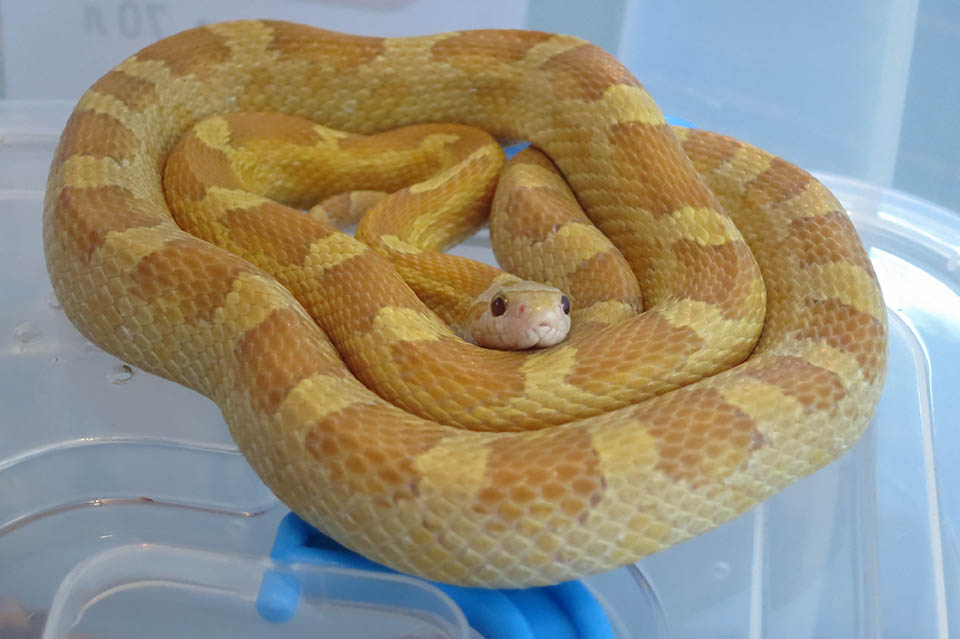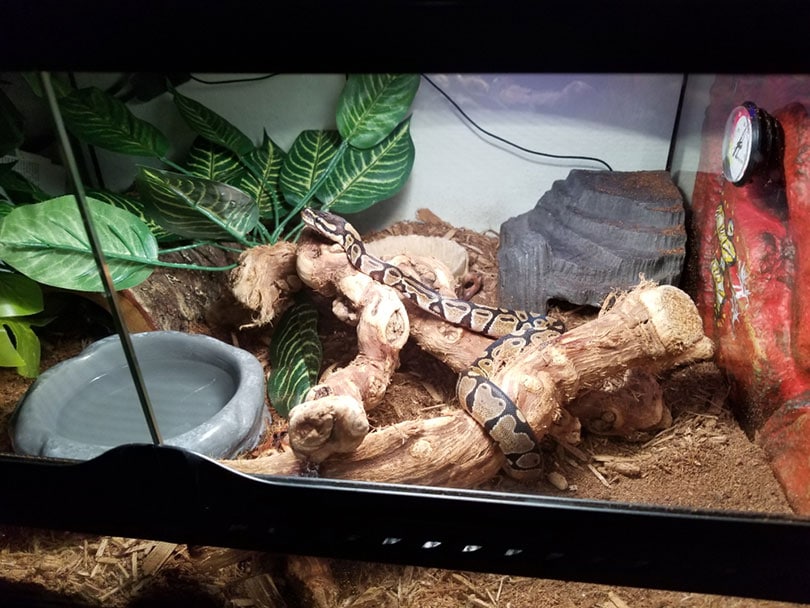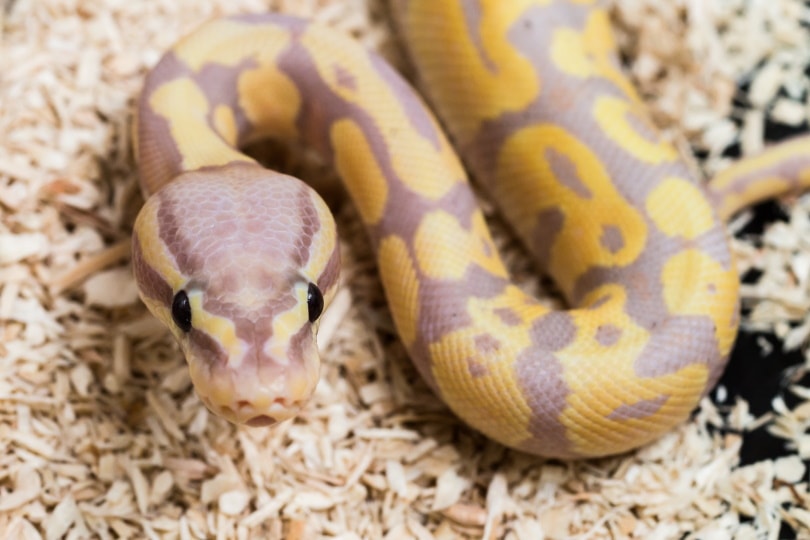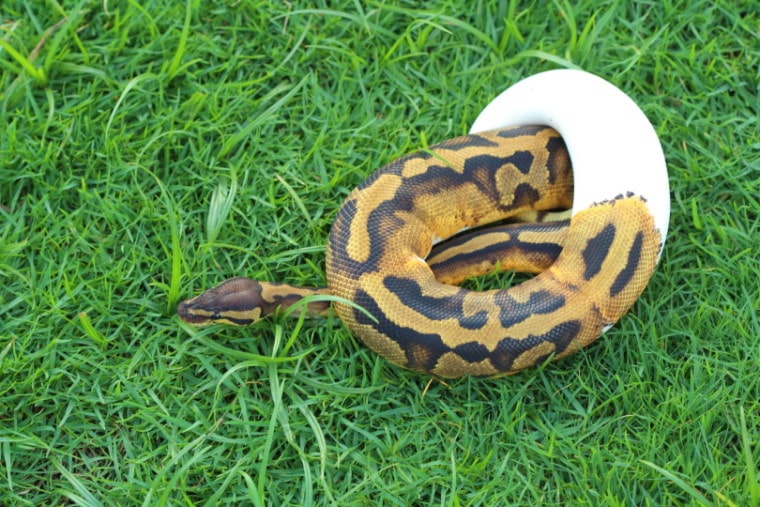
The Ball Python is one of the most popular reptiles kept as pets in America, and the Piebald morph is one of the most prized varieties. These highly sought-after snakes are becoming easier to find thanks to the rapid advancement of modern captive breeding practices. There has never been a better time to learn more about these attractive snakes, so keep reading while we take a deep dive to help you see if it would make a good pet for your home.
Quick Facts about Piebald Ball Python Morph
| Species Name: | P. regius |
| Common Name: | Ball Python |
| Care Level: | Beginner |
| Lifespan: | 30 years |
| Adult Size: | 30 – 72 inches |
| Diet: | Mice, rats |
| Minimum Tank Size: | 60 gallons |
| Temperature & Humidity
|
70 – 104 degrees |
Do Piebald Ball Python Morphs Make Good Pets?
Yes. The Piebald ball Python morph is a great pet and is even a good choice for beginners. The habitat is easy to set up and is relatively easy to maintain. The snake is slow-moving, even when handled, so there’s no need to be afraid of it. It will usually eat rats and can grow to more than five feet long. It has virtually no health issues outside the occasional digestive issue and can usually live to see 30 years or more.
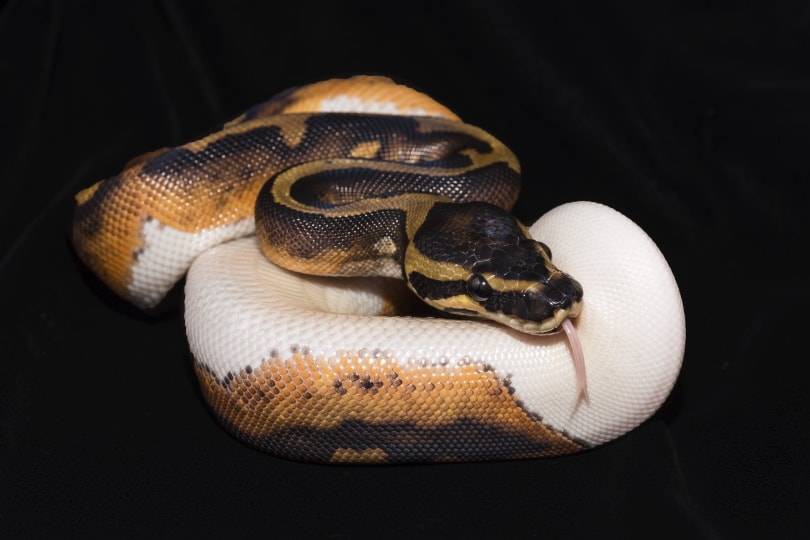
Appearance
Ball Pythons come in various colors and patterns, and your Piebald can have almost any of them. What makes your snake a Piebald is that it will have large patches that are completely white. A recessive gene causes some of the skin to be without pigment. It’s not common in the wild but is easy to create with captive-bred snakes.
How to Take Care of Piebald Ball Pythons
Habitat, Tank Conditions & Setup
Tank
Your Piebald Ball Python will require a 60-gallon aquarium when fully grown. You can use a smaller one before your sake is three feet long, but that will require you to purchase and create multiple habitats. Use a screen lid to provide your pet with plenty of fresh air without allowing it to escape. Your snake shouldn’t be too messy, so you will only need to clean out the tank if you notice a film on the windows or you are going to change the substrate.
You will also need a hiding hole on each side of the tank that your snake can use to get out of the heat and get some privacy. Many commercial hiding holes will work fine, as will a hollowed-out log as long as it’s large enough to fit the entire snake. You will also need a wag-n, and it will need to be large enough to not spill water if it takes a swim.
Lighting
Your habitat will require full spectrum heat lamps to help maintain temperature and make sure your pet receives the light of UVB needed that it would normally get from the sun. Not getting enough of this light could lead to health problems. It’s important to remember that many of these lights stop producing the important UVB light long before they burn out, so it’s best to check with the documentation to see how often you should replace the bulbs.
Heating (Temperature & Humidity)
Your Piebald ball Python requires high temperatures. It prefers to stay between 88 – 96 degrees but will tolerate temperatures down to 78 pretty well. It would be best if you never let the temperature fall below 75 degrees, not even for a short time, so we recommend using a thermometer and not trying to guess the temperature inside the tank.
Your Piebald Ball Python will like you to keep humidity between 50% and 60%. Most homes in the United States are in this range, but the health lamps could dry the air some, so it’s best to keep a small dish of water in the enclosure that will keep the humidity where it needs to be. We recommend using an ergometer to avoid guessing what the actual level is.

Substrate
Your Piebald Python Morph is not choosy about what type of substrate you use. The most popular ones are soil, sand, and wood shavings. Each of these will accurately recreate its natural environment and are easy to clean.
| Tank Recommendations | |
| Tank Type | 60-gallon glass vivarium |
| Lighting | UVB heat lamps |
| Heating | Heating pad/tape on bottom of enclosure and heat lamp |
| Best Substrate | Sand, woodchips, soil
|
Feeding Your Piebald Ball Python
Your Piebald Ball Python will eat almost exclusively mice and rats. While it’s still small, it will eat small pinky rats. Once your snake weighs more than about four ounces, you can switch to small fussy mice, and when it passes ten ounces, it’s best to switch to rats for the best nutrition. Your snake will get used to one type of food and eat it for its entire life. Rats are the healthiest choice, so it’s best to get them started as soon as possible. It will not need any treats, nor will it eat fruits and vegetables.
| Diet Summary | |
| Fruits | 0% of diet |
| Insects | 0% of diet |
| Meat | 100% of diet – small/medium sized rodents |
| Supplements Required | Occasional calcium dusting
|
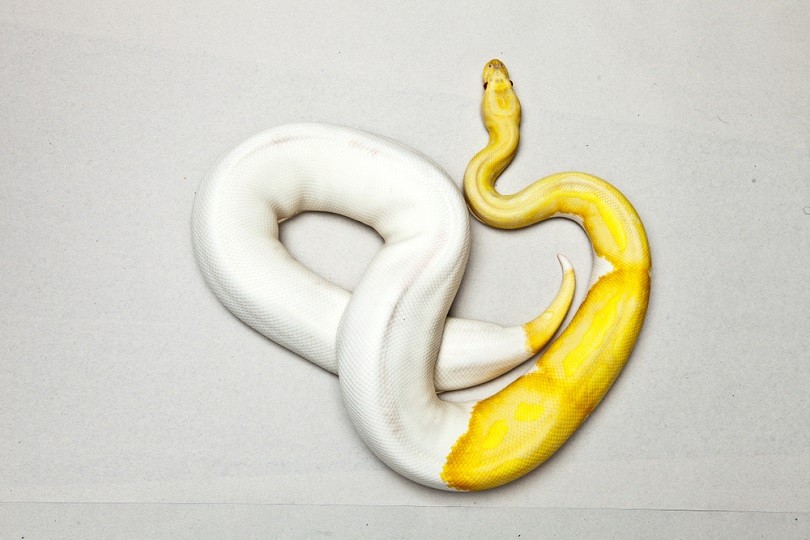
Keeping Your Piebald Ball Python Healthy
Keeping your Piebald Ball Python healthy is not a difficult task. It’s easy to set up and maintain the habitat, and since it eats whole rats, you don’t need to worry about dusting the food with calcium as you do with many other reptiles. Give it privacy while eating because they seem to be shy about it and don’t handle them for a few days after eating.
Lifespan
As long as you maintain the proper environment and diet, your snake will have a long lifespan, with many reaching more than 30 years old.
Breeding
Males need to be a foot and a half long to mate, and they reach sexual maturity around two years old. The mating process can take a long time, with many snakes taking weeks to finish breeding. Once complete, the female will produce one to eight eggs, with some making as many as 11. The eggs take about 60 days to hatch, but you need to keep them at 88 – 90 degrees while incubating.
Are Piebald Python Morph Friendly? Our Handling Advice
Your Piebald Python Morph is very friendly and easy to handle, at least while it’s still small. It’s a slow-moving snake that is very calm, and it won’t make any of the sudden fast movements other snakes make, so it’s perfect for someone inexperienced in snake handling. Our handling advice is to stay calm and hold the snake gently in your hands for a few minutes each day and allow it to explore. After a few days, you will feel comfortable and more at ease.
Shedding & Brumation: What to Expect
Your Piebald Ball Python will shed its skin every four to six weeks throughout its life. The shedding process can take up to two weeks. It will not be social during this time, so don’t try to pick it up, but increasing humidity can help speed up the process and make it easier. Rough surfaces like a thick branch can help them scrape off the skin, and once it finishes, you can pick it up.
How Much Do Piebald Ball Python Morphs Cost?
You can expect to pay between $400 and $800 for your Pibald snake due to the recessive genes a breeder will need to create it. However, prices are coming down quickly as more breeders enter the market and breeding skills increase, so if this price is out of range, keep checking with your local breeders for current prices.
Care Guide Summary
Final Thoughts
Due to its striking color, the Piebald is one of the most sought-after varieties of the hugely popular Ball Python snake. It’s easy to maintain, and the aquarium is not hard to set up. A few heat lamps to increase the temperature during the day and some heating pads at night will keep your pet healthy and happy. It will eat a rat every few days, so feeding is extremely easy, and you can purchase frozen food, so it’s easy to store. It makes a great pet for children and adults.
We hope you have enjoyed reading over our look into this rare type of snake and learned something new. If we have convinced you to seek a breeder to purchase one of these snakes, please share this guide to the Piebald Python Morph on Facebook and Twitter.
You May Also Like:
- Spinner Ball Python Morph: Facts, Pictures & Care Guide
- Axanthic Ball Python Morph: Pictures, Facts, & Care Guide
Featured Image Credit: Lamnoi Manas, Shutterstock


